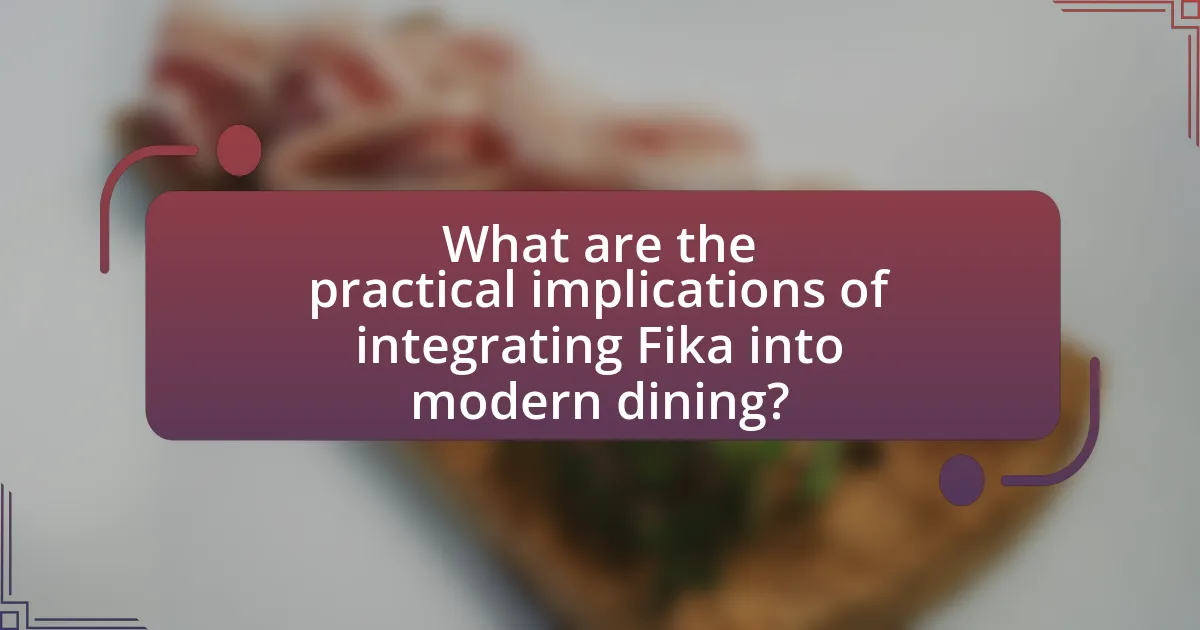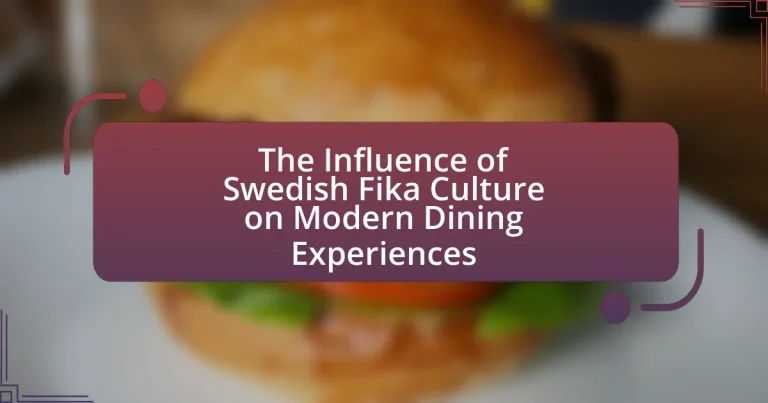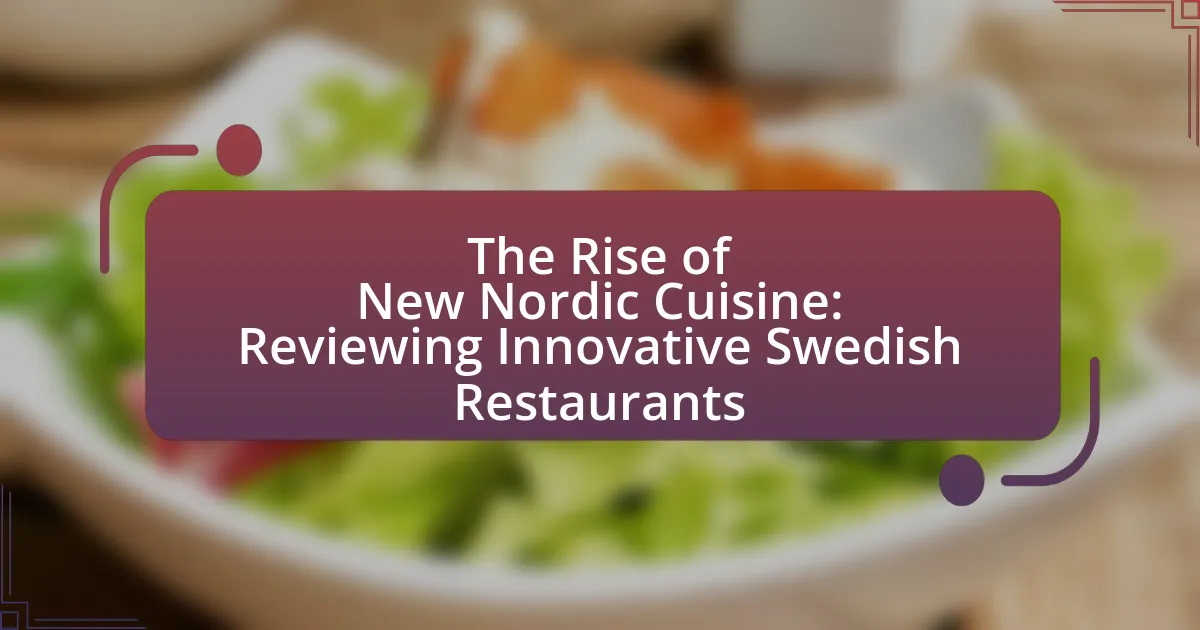The article explores the Swedish Fika culture, a social coffee break tradition that emphasizes relaxation and connection through coffee and pastries. It traces the origins of Fika back to the 18th century, highlighting its evolution into a vital aspect of Swedish work-life balance and community well-being. Key components of Fika, including traditional foods and the importance of setting, are discussed, along with its influence on modern dining experiences globally. The article also addresses the social benefits of Fika, its integration into contemporary dining, and the challenges of adapting this cultural practice outside Sweden.

What is the Swedish Fika Culture?
The Swedish Fika culture is a social coffee break that emphasizes taking time to enjoy coffee and pastries with friends or colleagues. This tradition is deeply rooted in Swedish society, where it serves as a moment to pause, relax, and connect with others, often occurring multiple times a day. Fika is not just about the food and drink; it embodies a philosophy of work-life balance and community, reflecting Sweden’s values of social interaction and well-being. The practice has gained international recognition, influencing modern dining experiences by promoting a more leisurely and communal approach to meals and breaks.
How did the concept of Fika originate in Sweden?
The concept of Fika originated in Sweden as a coffee break tradition that emphasizes social interaction and relaxation. Historically, Fika began in the 18th century when coffee became popular in Sweden, leading to the establishment of coffee houses where people gathered to enjoy coffee and pastries. This practice evolved into a cultural norm, promoting the idea of taking a break to connect with others, which is now an integral part of Swedish work and social life. The significance of Fika is reflected in its role in fostering community and well-being, making it a vital aspect of Swedish culture.
What historical events contributed to the development of Fika?
The development of Fika in Sweden was significantly influenced by the introduction of coffee in the 17th century, which became a popular beverage among the Swedish population. The Swedish East India Company played a crucial role in importing coffee, leading to its widespread consumption. By the 18th century, coffee houses emerged as social hubs, fostering a culture of taking breaks for coffee and pastries. Additionally, the industrial revolution in the 19th century contributed to the establishment of a structured workday, making the practice of Fika a necessary social ritual for workers to relax and connect during breaks. These historical events collectively shaped Fika into a cherished cultural tradition in Sweden.
How has Fika evolved over time in Swedish society?
Fika has evolved from a simple coffee break into a significant cultural practice in Swedish society, emphasizing social interaction and well-being. Initially, in the 18th century, fika referred to a coffee and cake break among the upper class, but it gradually permeated all social classes, becoming a daily ritual by the 20th century. The introduction of coffee houses in urban areas further popularized this practice, making it a communal experience. Today, fika is recognized not only as a time for coffee and pastries but also as a vital aspect of Swedish work culture, promoting work-life balance and fostering relationships among colleagues. This evolution reflects broader societal values of community and mindfulness, making fika an integral part of modern Swedish dining experiences.
What are the key components of a traditional Fika?
The key components of a traditional Fika are coffee, pastries, and social interaction. Fika typically involves enjoying a cup of coffee, often accompanied by sweet treats such as cinnamon buns or cookies, while engaging in conversation with friends or colleagues. This practice is rooted in Swedish culture, emphasizing the importance of taking a break and connecting with others, which has been shown to enhance workplace morale and foster relationships.
What types of food and beverages are typically served during Fika?
During Fika, traditional Swedish coffee breaks, coffee is the primary beverage served, often accompanied by a variety of baked goods. Common food items include cinnamon buns, known as kanelbullar, and other pastries such as cardamom buns and cookies. Additionally, open-faced sandwiches, or smörgås, may also be offered. This practice emphasizes social interaction and relaxation, making it a significant aspect of Swedish culture. The combination of coffee and sweet treats during Fika reflects the importance of taking a break and enjoying simple pleasures in daily life.
How does the setting influence the Fika experience?
The setting significantly influences the Fika experience by creating an atmosphere conducive to relaxation and social interaction. In Sweden, Fika typically occurs in cozy, inviting spaces such as cafés or homes, where the ambiance encourages conversation and connection. Research indicates that environments with comfortable seating, natural light, and aesthetic appeal enhance the enjoyment of social rituals like Fika, promoting a sense of well-being and community. For instance, a study published in the Journal of Environmental Psychology highlights that pleasant surroundings can elevate mood and foster social bonds, which are essential elements of the Fika tradition.
Why is Fika considered important in Swedish culture?
Fika is considered important in Swedish culture because it represents a social institution that emphasizes the value of taking a break to enjoy coffee and pastries with friends or colleagues. This practice fosters community and strengthens relationships, as it encourages people to pause their busy lives and engage in meaningful conversations. Historically, Fika has roots in the 18th century when coffee became popular in Sweden, and it has since evolved into a cherished tradition that reflects the Swedish values of work-life balance and social connection. Studies indicate that regular breaks, such as those taken during Fika, can enhance productivity and well-being, further solidifying its significance in Swedish society.
What social benefits does Fika provide to individuals and communities?
Fika provides significant social benefits to individuals and communities by fostering connections and enhancing well-being. This Swedish coffee break tradition encourages social interaction, allowing people to engage in meaningful conversations, which strengthens relationships and builds community bonds. Research indicates that regular social interactions, such as those experienced during Fika, can lead to improved mental health and reduced feelings of isolation. Additionally, Fika promotes a culture of mindfulness and relaxation, contributing to overall life satisfaction and work-life balance. These elements collectively enhance social cohesion within communities, making Fika a valuable practice for both individuals and society at large.
How does Fika contribute to work-life balance in Sweden?
Fika contributes to work-life balance in Sweden by promoting regular breaks that enhance social interaction and reduce stress. This cultural practice encourages employees to step away from their workstations, fostering a sense of community and collaboration. Research indicates that such breaks can improve productivity and job satisfaction, as they allow individuals to recharge mentally and physically. In Sweden, the integration of fika into the workday is seen as essential, with studies showing that companies that embrace this practice often report lower burnout rates and higher employee morale.

How has Swedish Fika Culture influenced modern dining experiences?
Swedish Fika culture has significantly influenced modern dining experiences by promoting a focus on social interaction and mindfulness during meals. This cultural practice emphasizes taking breaks to enjoy coffee and pastries with friends or colleagues, which has led to the incorporation of similar communal dining practices in various settings, such as cafes and restaurants worldwide. Research indicates that establishments that embrace a relaxed atmosphere and encourage socialization, akin to Fika, see increased customer satisfaction and loyalty. For example, a study published in the Journal of Hospitality and Tourism Management highlights that dining experiences that prioritize social connections enhance overall enjoyment and can lead to longer visits and higher spending.
What trends in dining have emerged from the Fika concept?
The Fika concept has led to several emerging trends in dining, primarily emphasizing social connection and mindfulness during meals. This Swedish tradition encourages taking breaks to enjoy coffee and pastries, fostering a communal atmosphere that promotes conversation and relaxation. As a result, modern dining experiences increasingly incorporate designated social spaces, where patrons can engage in leisurely interactions rather than rushing through meals. Additionally, the focus on quality over quantity has gained traction, with restaurants offering curated menus that highlight artisanal ingredients and homemade items, reflecting the Fika principle of savoring food. This shift is supported by studies indicating that dining experiences centered around social engagement enhance customer satisfaction and loyalty.
How are cafes and restaurants incorporating Fika into their menus?
Cafes and restaurants are incorporating Fika into their menus by offering dedicated Fika experiences that include coffee and a selection of pastries or light snacks. This practice reflects the traditional Swedish custom of taking a break to enjoy coffee and conversation, which enhances the dining experience. Many establishments feature specific Fika menus that highlight traditional items such as cinnamon buns, cardamom bread, and various cakes, often served alongside specialty coffee or tea. This integration not only promotes social interaction but also aligns with the growing trend of experiential dining, where the focus is on creating a relaxed atmosphere for patrons to unwind.
What role does Fika play in the design of modern dining spaces?
Fika plays a significant role in the design of modern dining spaces by promoting social interaction and creating a relaxed atmosphere. This Swedish tradition emphasizes taking breaks for coffee and pastries, which influences the layout and ambiance of dining areas to encourage gatherings. For instance, many contemporary dining spaces incorporate communal tables and cozy seating arrangements that facilitate conversation and connection among guests, reflecting the essence of Fika. Research indicates that environments designed for social engagement enhance customer satisfaction and overall dining experiences, aligning with the principles of Fika.
Why are people outside Sweden adopting Fika practices?
People outside Sweden are adopting Fika practices primarily to enhance social connections and promote well-being in their daily routines. Fika, which involves taking a break to enjoy coffee and pastries with others, fosters a sense of community and encourages relaxation. Research indicates that social interactions during breaks can improve mental health and productivity, making Fika an appealing practice for individuals and organizations seeking to create a more supportive work environment. Additionally, the global trend towards mindfulness and work-life balance aligns with the principles of Fika, further driving its adoption beyond Sweden.
What cultural exchanges have facilitated the spread of Fika globally?
Cultural exchanges that have facilitated the spread of Fika globally include the rise of social media, international travel, and the globalization of coffee culture. Social media platforms have allowed users to share images and experiences of Fika, showcasing its significance as a social ritual in Sweden. International travel has enabled tourists to experience Fika firsthand, leading to its adoption in various countries. Additionally, the globalization of coffee culture has created a demand for unique coffee experiences, making Fika an appealing concept for cafes and restaurants worldwide. These exchanges have contributed to Fika’s integration into diverse dining experiences, promoting a communal approach to coffee and pastries.
How do international interpretations of Fika differ from the original?
International interpretations of Fika often emphasize social interaction over the traditional Swedish focus on coffee and pastries. While the original Fika is a structured break that includes specific elements like coffee, cinnamon buns, and a relaxed atmosphere, international adaptations may incorporate various beverages and snacks, reflecting local customs and preferences. For instance, in countries like the United States, Fika might be interpreted as a casual coffee break without the same cultural significance or ritualistic elements found in Sweden. This shift highlights a broader trend where the essence of Fika as a mindful pause is sometimes overshadowed by a more commercialized or informal approach in different cultures.

What are the practical implications of integrating Fika into modern dining?
Integrating Fika into modern dining enhances social interaction and promotes well-being among diners. This Swedish tradition emphasizes taking breaks for coffee and pastries, fostering a relaxed atmosphere that encourages conversation and connection. Research indicates that social interactions during meals can improve mental health and reduce stress levels, making dining experiences more enjoyable and fulfilling. Additionally, incorporating Fika can differentiate dining establishments by offering unique experiences that attract customers seeking a blend of culinary enjoyment and social engagement.
How can restaurants effectively implement Fika-inspired experiences?
Restaurants can effectively implement Fika-inspired experiences by creating a dedicated space for social interaction and offering a menu that emphasizes coffee, pastries, and light snacks. This approach aligns with the essence of Fika, which is centered around taking a break to enjoy food and conversation. For instance, incorporating traditional Swedish pastries like cinnamon buns and cardamom bread alongside high-quality coffee can enhance the authenticity of the experience. Additionally, promoting a relaxed atmosphere with comfortable seating and communal tables encourages guests to linger and engage in conversation, reflecting the social nature of Fika. Research indicates that such environments can increase customer satisfaction and loyalty, as they foster a sense of community and well-being among patrons.
What strategies can be used to create a welcoming Fika atmosphere?
To create a welcoming Fika atmosphere, it is essential to focus on comfortable seating arrangements, inviting decor, and a relaxed pace of service. Comfortable seating encourages guests to linger and engage in conversation, which is central to the Fika experience. Inviting decor, such as warm lighting and natural elements, enhances the ambiance and makes the space feel cozy. Additionally, a relaxed pace of service allows guests to savor their coffee and pastries without feeling rushed, fostering a sense of community and connection. These strategies align with the traditional Swedish Fika culture, which emphasizes social interaction and enjoyment of simple pleasures.
How can menu design reflect the principles of Fika?
Menu design can reflect the principles of Fika by emphasizing a selection of coffee, pastries, and light meals that encourage social interaction and relaxation. This approach aligns with Fika’s core values of taking a break and enjoying quality time with others. For instance, including items that are traditionally associated with Fika, such as cinnamon buns and strong coffee, fosters a cultural connection and enhances the dining experience. Additionally, the layout of the menu can promote sharing by highlighting options that are meant to be enjoyed communally, thus reinforcing the social aspect of Fika.
What challenges might arise when adopting Fika in non-Swedish contexts?
Adopting Fika in non-Swedish contexts may face challenges such as cultural misunderstanding and differing workplace norms. Cultural misunderstanding can arise because Fika is deeply rooted in Swedish social customs, which may not translate well to other cultures that prioritize efficiency over social interaction. Additionally, differing workplace norms in other countries may not support the concept of taking extended breaks for socializing, as seen in Sweden, where Fika is integrated into the workday. These challenges highlight the need for careful adaptation of Fika practices to align with local customs and expectations.
How can cultural misunderstandings be addressed in Fika implementation?
Cultural misunderstandings in Fika implementation can be addressed through education and open communication. Educating participants about the origins, significance, and practices of Fika fosters a shared understanding, reducing the likelihood of misinterpretation. For instance, emphasizing that Fika is not merely a coffee break but a cultural ritual promoting social interaction can clarify its importance. Additionally, encouraging dialogue among diverse participants allows for the sharing of perspectives and experiences, which can highlight and resolve potential cultural differences. Research indicates that cross-cultural training enhances team dynamics and reduces misunderstandings in multicultural settings, supporting the effectiveness of these approaches in Fika implementation.
What are common pitfalls to avoid when introducing Fika to new audiences?
Common pitfalls to avoid when introducing Fika to new audiences include neglecting cultural context, misrepresenting the experience, and overlooking dietary preferences. Neglecting cultural context can lead to misunderstandings about the significance of Fika as a social ritual in Sweden, which emphasizes connection and relaxation. Misrepresenting the experience by treating Fika merely as a coffee break diminishes its cultural value; it is meant to be a time for conversation and enjoyment of pastries. Overlooking dietary preferences can alienate participants; offering a variety of options, including gluten-free and vegan choices, ensures inclusivity and enhances the experience.
What tips can enhance the Fika experience in modern dining?
To enhance the Fika experience in modern dining, focus on creating a relaxed atmosphere that encourages social interaction. This can be achieved by incorporating comfortable seating arrangements and soft lighting, which promote a sense of intimacy and connection among diners. Additionally, offering a variety of high-quality coffee and traditional Swedish pastries, such as cinnamon buns and cardamom bread, can elevate the culinary aspect of Fika. Research indicates that shared food experiences foster stronger social bonds, making the selection of pastries crucial for a successful Fika. Furthermore, integrating elements of Swedish design, such as minimalistic decor and natural materials, can create an inviting environment that reflects the essence of Fika culture.





